by Dinar Khayrutdinov, originally published in eRazvitie.org, January 2016
An amazingly effective method of teaching called “Blended Learning” has become one of the staples of modern education in many places of the world. One of its early developers was famous American teacher of journalism, author of the book “Moonshots in Education: Launching Blended Learning in the Classroom” Esther Wojcicki, who bases her approach on trust and respect to students, as well as provides them with creative freedom and supports their initiative. Her students, who lovingly call her “Woj”, succeed by finding jobs in media, business, government administration and even Hollywood, while Esther Wojcicki herself was selected as the California Teacher of the Year in 2002, as well as awarded honorary doctorate degrees of Palo Alto University (2013) and Road Island School of Design (2016). In a talk with eRazvitie Esther told us about how Blended Learning helps both students and teachers.
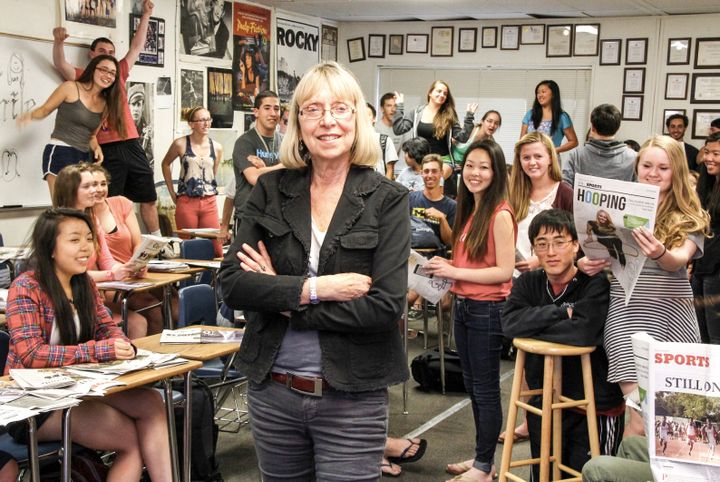
Esther Wojcicki American teacher of journalism, author of the book “Moonshots in Education: Launching Blended Learning in the Classroom”
– Dear Esther, you speak a lot publicly, publish books and articles, and you often state that education is in need of change, that they teach in schools today just the same way they used to teach many years ago. But what exactly needs to be changed and what does education have to lose if these changes do not occur?
The number one change that has to take place is that teachers, policy makers and administrators need to realize that the way that we get information has changed dramatically, and that they are ignoring that and still trying to teach the way they did before the digital age. And as long as they continue to teach in a way that doesn’t really relate to the world today the students are not going to get an opportunity to self-direct their learning as well as to be innovative and creative. Most students go to school for seven to eight hours a day, and these hours entirely consist of lectures, taking notes and then taking tests. And at the same time there is very little interaction and no opportunity to think by yourself and draw your own conclusions. The schoolchildren are constantly in a state of following directions. But if you look at the people who were the most innovative and the most creative in the history of mankind, they were the people who did not follow the rules.
– What do you think is the solution to this problem?
I think modern technology can help. For instance, instead of lecturing to students on some war, you can ask them to go online and find information about it; and then put them in groups where they will share the information they found. That doesn’t mean the teachers still can’t lecture, but they can cut it back to 50% of the time without really sacrificing anything. Because just taking this step to find the information by themselves teaches students that they can spend a lifetime of doing that, they don’t have to have a teacher constantly guiding them. And a lot of people leave school thinking that they can’t learn anything else because there is no teacher there to tell them what to do. But after they leave school or college they continue to just follow directions – this time from their bosses at work, from the government, etc. And that’s very sad both for them and for society.
– You wrote a whole book about your concept of Blended Learning. However, could you please briefly explain the essence of this idea to our readers? Why is it that you offer to cultivate such qualities as Trust, Respect, Independence, Collaboration and Kindness in a classroom? How does Blended Learning help to develop these qualities in students?
Blended Learning is a blend of the old method and the new method, a mix of the lecture-based approach and of technology-empowered education. As for the qualities you mentioned, they come naturally from this. If give your students a computer and then say to them: “I want you to find information about the 1950s in Russia”, for example, by that you are trusting them to go online and find this information. And if they don’t do it, of course, then they have violated your trust. But believe me, it’s a very different feeling for school students to have somebody trust you enough to get this information, to learn by yourself. It’s not at all the same as being in a classroom where you are told you have to sit there and listen and punished when you don’t. So that’s what is meant by Trust. But I carry the notion of Trust even further: I trust my students to come up with their own ideas for stories to write about. Most teachers would never do that, because they don’t believe in their students’ ability, they think they don’t have the intelligence and the maturity to come up with their own ideas. So, when a teacher thinks this, they subconsciously pass this deception on to the student, and the student feels incapable. And that’s why a teacher should never say nasty things to a student like “You’re never going to amount to anything”. I’ve heard teachers say that many times, and imagine what it can do to the kids’ self-esteem. They are young and vulnerable and this is destructive for their minds.
I think that when you trust your students you also respect them, Trust and Respect go hand-in-hand. Unfortunately, in most education the respect is a one-way street. The teacher is the only one who is supposed to be respected.
And the same can be said about Independence, Collaboration and Kindness: orientation towards these things is the logical consequence of the approach when part of the time is given to students so that they can implement their own creative ideas.
Most of the teachers are very reluctant to give students initiative and let them personalize their education. So I came up with this idea which I called the “20% time” or “Moonshot Monday”. This means we give the students complete freedom but only during 20% of their school time. And this should be built into the curriculum. It can be one day a week (hence the “Moonshot Monday” name), or alternatively, instead of an hour-long lecture, you could lecture for forty minutes and give the students the rest twenty to go online and find information and then talk about it. And they learn something when they do it. Just imagine all the things in life that you learned by doing: you learn to ride a bike, you learn to swim, you learn to do sports. You can’t read a book about being creative and then just become a creative person. You need to do something, go out and try your creativity!
– A lot of experts talk about specific skills needed in the post-industrial age. For instance, Dr. Patrick Griffin of the University of Melbourne, who we once interviewed, names critical thinking, collaboration, communication and creativity. How does that relate to your idea of promoting Trust, Respect, Independence, Collaboration and Kindness?
Well, the skills Dr. Griffin talks about is exactly what I teach through my program. All of these skills are needed in the current age and you can’t learn them by just sitting in rows and never talking to the other students. My students acquire these skills by being independent and creative during my journalism class. For instance, they learn communicative skills by constantly communicating in both spoken and written forms. To complete their projects, they have to communicate with each other, post web content, make magazines and newspapers, keep blogs and talk to readers. And when we do news writing, opinion writing and editorial writing with them, they learn critical thinking. Because for any kind of news story a reporter has to go out there and collect a lot of information. And if they are doing a good job, they need to get information on both sides, which means the reporter will have a notebook full of information. And then they have to figure out how to select the most important information out of that mishmash. But most people, even grownups, cannot really decide what’s most important. It takes school students at least ten weeks to master this skill. Before that they want to give you the story in chronological order. That’s the most obvious way, if you think about it, and that’s also the way most people lecture – in chronological order, which is why we’re all put to sleep at these lectures. You only wake up at the end when the main point comes. But it’s important to write so that then other people can read it, to put it together well, to be concise and clear enough. I usually say it’s harder to write 100 words than it is to write 300 words.
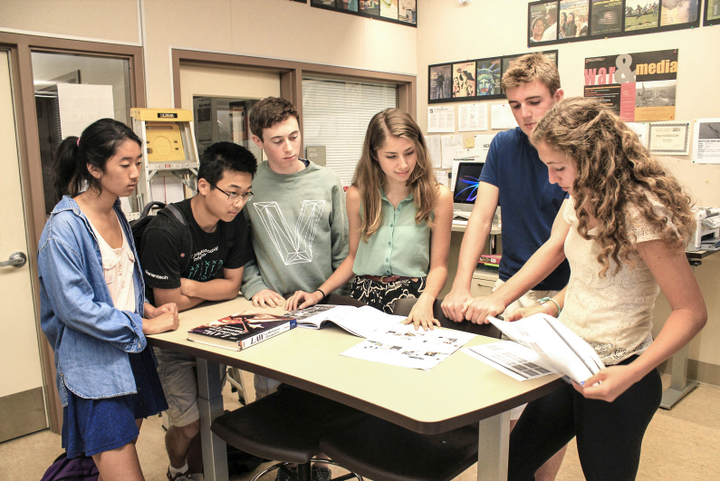
– You have this type of classwork when students form small groups and work on certain projects together. Is this approach also a part of Blended Learning?
Yes, it’s a part of Blended Learning, and it’s something I give special attention to. If you read some other books on Blended Learning or similar approaches, they tell you specifically how to put students together in groups. There are always different patterns of dividing the class into groups and rotating them, so that they stay in groups for 20 minutes and then move for another 20 minutes, for instance. But I don’t do that. I let the kids pick their own group. There is only one condition: every student must be a part of this or that group.
And the other teachers say: “But what if they just don’t do anything? Or if every group has one or two people working, and the others doing nothing?” Well, if all these groups are working together on a large collaborative project, trust me, there is going to be a lot of peer pressure for them to work. The other kids are going to get mad if someone doesn’t do their work, because they won’t want to work for them. And there is also this very important thing: you need to learn to work with everybody, not just the people you like. I say to my students: “Go home and ask your parents if they love all the people they work with. And if they say yes, then I’ll let you not work with people you don’t like.” But that has never happened so far. So, it’s really important for them to pick their own groups and to work in teams, but also it’s important that nobody is left out.
And after they pick their group, they put together a newspaper. 28 pages. Can you imagine how much they have to interact with each other? I mean, the paper is the size of the New York Times, with three sections, and it comes out every three weeks. So they simply don’t have time to sit around and do their fingernails.
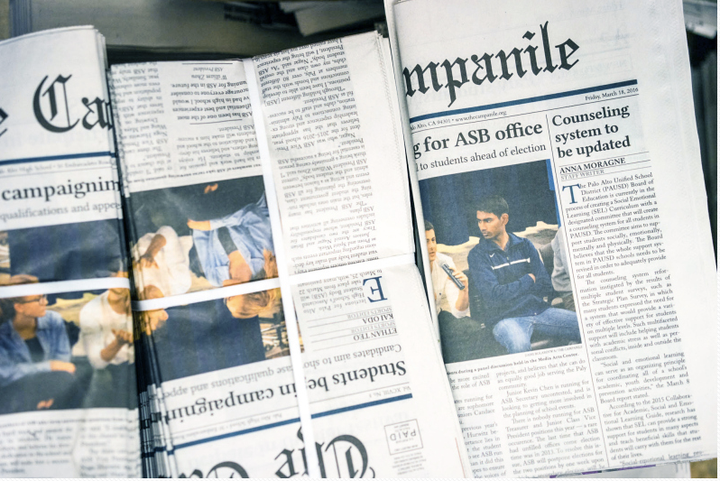
Campanile newspaper published bimonthly
– In one of your interviews you touched upon the following idea: in the traditional school system all students learn the same thing in class. But when working in small groups it’s easy to find out what every student is more interested or inclined to do (for instance, some may enjoy writing more, the other ones prefer editing, someone else likes making newspaper layouts or taking pictures, etc.), and subsequently you can accentuate exactly these prevalent skills for each of the children and work predominantly on whatever each of them is best at. Is that so?
That’s right but there is one stipulation. Each of my students has to write at least one article about something that they care about. I make every single kid write stories, even if they are photographers or managing editors. But in addition to that they can pick some other role. Some kids that volunteered to be business managers in my class ended up being CEOs of their own companies. And I didn’t tell them to be business managers, that was their conscious choice. Whatever they want to be or are interested in is what I try to encourage.
So the mandatory part is writing stories. The voluntary part is that they get to do another activity of their choice.
Of course, I put forward some requirements to their work. One of the important requirements I have is that they have to sell advertising, to actual people for actual money. Because all the publications are self-supporting. And this is the hardest thing they have to do. At first they are terrible at selling advertisements. They don’t know how to talk to people, they don’t know how to frame their arguments to convince the sponsors. They get rejected probably 75% of the time. But this is why they learn from this. And I say to them: “It’s difficult for you now, but you need to learn it, because you’ll be doing it in life all the time.” Because we constantly sell things to somebody: you sell your skills, your projects, your ideas; you try to raise money for the projects you do. There is always this selling of something, and the earlier you learn how to do it the better. These are entrepreneurial skills, and they don’t teach them anywhere else in the curriculum. That’s why I think if kids can work on projects that need funding they should learn to go and raise money to get the project done. Luckily, the Palo Alto community is very supportive of the journalism programs: they buy the advertising, they help, and they answer questions when kids interview them.
– How did the idea of Blended Learning first come to your mind?
Once I realized that the more I did for my own three daughters, the less empowered and confident they were themselves. I think that the idea of Blended Learning started with that realization. And I wanted my children to be as independent as possible.
– I think you really succeeded in that! (Esther Wojcicki’s daughters are: Susan, CEO of YouTube (in 2015 she was named 9th most influential woman in the world by Forbes magazine); Janet, Fulbright-winning pediatrician, anthropologist, epidemiologist and researcher at the University of California; Anne, co-founder and CEO of the world-famous personal genomics and biotechnology company 23andMe (in 2008 the company’s DNA-testing service was named “invention of the year” by Time magazine) – ed.)
Indeed I succeeded in that beyond my wildest dreams. I wanted to make sure that they always felt they were in control of whatever they needed. We had a swimming pool in our home, and I taught them all to swim when they were one and a half years old. My theory behind that was: I cannot watch them every minute like crazy. So if they accidentally fall into the pool, they’d better figure out how to get out of that pool by themselves. And that extended to a lot of things. I taught them how to read early because I wanted to give them a tool so that they could learn anything they wanted by themselves. I taught them how to ride a bike when they were very young. And I used the same basic principles I’ve already told you about: a lot of trust and a lot of respect.
And when they grew up a bit and I returned to teaching at school, I had to follow the curriculum, because new teachers always have to do what they’re told to do. Very soon I realized it was just not very successful. And after two years of struggling, I just threw away the book. I also got tenure at that point, so that gave me some courage. Instead of the textbook I brought in real newspapers. I slowly began moving toward this model I work with today. I had kids write things that they cared about, although I was still not giving them as much control as I do today. At that time I usually was in charge of the class. If you came into the class, you would see me standing in front. Today if you come into my class, you might not even notice me anywhere, I’ll be somewhere in the back. It’s the students who are in the front, they are in control. But it took me a few years to get there, because there was a lot of criticism of my style from the school management. People didn’t understand my approach; they assumed that I’d be lecturing all the time, that I should be in charge. But eventually they saw that the kids were learning more, and that they were happy and that the number of students enrolled to my program was growing, and only then they gave me more freedom.
– The results of you educating your children, your three daughters, are obviously fantastic. But what about the results of you educating the schoolchildren? In general, what results does your method allow to achieve? What qualities and skills can teachers cultivate in their students with the use of Blended Learning? Who do you think is the most interested in such shift in education – is it the government, the major corporations, the education system, the students/schoolchildren or maybe their parents?
To answer your first question, the result is very highly motivated and empowered students that are able to succeed in their professional careers. All of my students went to college and most graduated, which is an incredible record on its own. But also about 95% of them are employed in some kind of a leadership role. There are a lot of CEOs, doctors, lawyers, leaders of professional organizations. I have students that are in the government, I have students in major American printed newspapers – the New York Times, the Washington Post, the Los Angeles Times. I even have a Hollywood actor and director who was a student of mine. It’s James Franco, who also wrote an introduction to my book, and if you like you can find some videos online where he talks about our classes.
So, my students are practically in all fields. And my theory has always been that you can be whatever you want to be. The important thing is to have this desire. Another important thing is that if you fail, you need to get back up and do it again. And that’s carried out in the way I teach writing. I usually have my students revise everything over and over before getting a grade. So if they write it badly they have to redo it. I just mark it up and they have to redo it again and again until it’s publishable. So sometimes they have to redo their work two times, and sometimes they have to redo it ten times. But that’s simply because each of them learns differently and at a different pace, and I’m giving them ways to do that. And this plays out just in general in their lives because if you fail at something you’re trying to do you just do it again, you don’t give up or take it personally. That’s life, you know, there’s a lot of failure in it.
Regarding the question of who benefits from this: the employers benefit greatly. Everyone is looking for employees who have creativity and communication skills, collaboration skills and critical thinking. It’s really important for them to get that. They want to hire these kids when they are still in high school, and this is also significant.
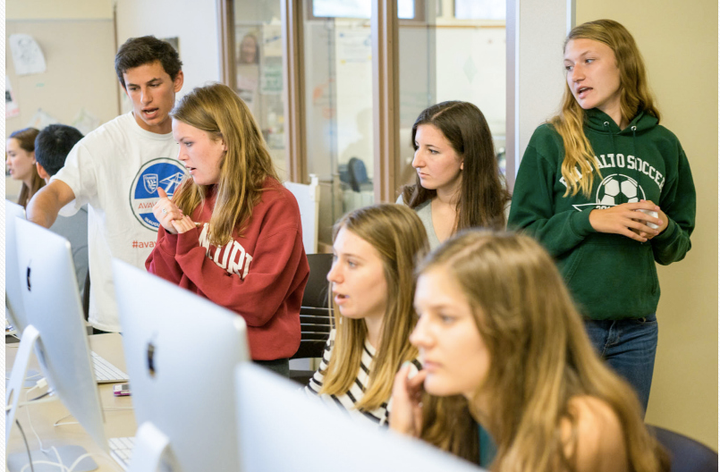
– What exactly makes Blended Learning effective? Is it just the form of class organization, or does the content of education change as well? Does Blended Learning imply teaching essentially the same things as before or teaching something else? In other words, is it about how you teach or what you teach?
It is definitely about how you teach. But there is also another thing. If you can study something you care about, you will have the best possible results. And my approach is basically interest based learning supported by technology, that is the main factor here. Do you know why Google is such an effective company? One of the reasons is because they give their employees 20% of the time (i.e. one day a week) when they can work on a project that they choose, within reason. And just having that psychological state of mind when you can think of what you really want to do, make all your own plans and ambitions come true, and you actually have special time reserved for just that. I think that’s the key factor that promotes creativity among Google employees.
Or take small children – you never have to ask them: “Do you want to learn this or not?” Small children are always asking questions and they’re always happy to learn new stuff. Because learning is natural. It’s only when they get to school they get confined: sit in a chair, do what you’re told. But if we could just continue that sort of energy that kids start with just for a certain part of the time, then I think we could provide workers that today’s employment market needs. And on top of that imagine how much difference we would make in the young people’s lives, in the lives of our children. You see, one of the reasons we had all these people in the United States who voted for Donald Trump is because they really are upset that they can’t get their old jobs back. They want things to get back to what they used to be because they can’t think any other way. But if earlier in life they had an opportunity to think about creative ways to solve problems, they wouldn’t want some guy to give them back their job of coal mining, for instance. I feel very sorry for these people. They are trapped in their own self-deception.
– Dr. Patrick Griffin I have already mentioned also believes that any changes in education happen very slowly and are very difficult to manage. It is not easy to make students and especially teachers to readjust, to change their daily routine, to abandon something they are really used to doing. Do you agree with that? What qualities and (intellectual, financial and timing) resources will this change require from education professionals?
True, it is very difficult to change education, and it’s because education is an institution that is supposed to pass on tradition, culture and the way people live. So it’s a conservative system by definition. People tend to teach the way they were taught and to parent the way they were parented. It’s instinctual, which is why it’s very hard to change this. But you can motivate teachers by telling them that first of all it will be easier for them to teach this way, and they won’t have to work this hard. The second reason: they will have a better relationship with their students who will still respect them but now the respect will go both ways. And number three: the students will actually learn more and achieve better results.
So just have to explain the teachers these three things, and then give them training. But you can’t simply force teachers to do this, because after a teacher closes that classroom door, they will teach the way they deem necessary, and you can’t do anything about it. So, you need to talk to instructors, to convince them, they must understand that this change is beneficial both for themselves and for the students. And they will understand. I actually never had an audience that did not understand us, because every single person, including me, has gone through that experience of suffering through classes that meant nothing for them, and they had to sit there for hours taking notes on stupid things that they don’t care about.
– How widespread is Blended Learning now?
It is spreading, it is now happening everywhere. People are getting the message, they understand this. Here in Palo Alto High School we even have a special Blended Learning training program, and the teachers get paid 1800 dollars extra for taking the training. Then we let them come up with their own curriculum, design the program they want. So we’re giving the teachers the same power and control we’re giving the students.
Blended Learning has become quite widespread in the United States, now it’s being taught as part of teacher training programs in some universities and colleges. I’ve been talking about this a lot in the US, and I also just came back from Mexico a couple of days ago, and my book has been published in Spanish there. Soon I’m going to be speaking about it in all the Latin American countries as well as Spain. And it makes sense to everybody. We are not giving up the old, academic style of instruction, we are just giving up some of the time so that we can teach the 21st century skills, as Patrick Griffin calls them. Because otherwise we are not going to have any 21st century skills, but instead we’ll be left with the same skills that people had in the 19th and 20th centuries – the factory model, the industrial age skills. If we want a society where everyone just blindly follows instructions, then just don’t give kids any control of their learning, or you might teach them to think. And some societies don’t want people to think, they want them to just follow the rules.
– A lot of researchers think that very soon traditional tests and exams will be mostly substituted with project work. And what is going to be assessed is not just the result of these projects but mostly and even primarily the project participants’ level of collaboration and creativity. Do you agree with that? What assessment system do you consider to be the most effective?
To be honest, I’m actually looking forward to the elimination of tests. Right now we’re still testing, but I only use projects to assess my students – for me it’s more important what they have learned to do and how well they’re learned to do it, not how many different things they know. And if you ask me about their academic results, I can simply show you a newspaper they have done. It makes it easy to see the evaluation, their strengths and weaknesses are all there in the product of their work.
But my students still have to take tests, because they are required by the state. But what’s interesting is that even though I don’t prepare them to take tests, they usually test very high (very often they test at the top in fact), because they use those skills that they’ve learned in their projects.
– Does Blended Learning have any disadvantages though? Or, let’s put it another way – what are the difficulties a teacher has to face when using this approach?
I think the main difficulty is that there might be students who are unwilling to learn, or students who are so used to being controlled and told what to do by their teacher that when they’re given freedom they don’t know how to function. And then these kids start fooling around and creating problems for themselves and their classmates. I can tell you right away that there are always people like that. Here’s a good example of that. There’s a school group in the USA called the KIPP Schools – it’s a charter school system where the students’ every step is totally controlled, they even wear uniforms to school. They come to school at 7:30 in the morning and they leave at 6 o’clock at night, and the control is just continuous all the way to the twelfth grade. At the end of the twelfth grade these kids sign on to go to college, but their graduation rate from college is only 3%. And it’s all because these kids are so controlled that they never internalize this control, it is all external. When they have to act independently they can’t do it. And I think that when a teacher first starts working with Blended Learning they’re going to end up with students who don’t know how to organize themselves.
You just have to give these kids time. The teachers need to understand that it can’t go perfectly from day one. And also you have to build some controls anyway. For instance, the thing that I control on the newspaper and the magazines is the deadline. If you don’t set up the deadline, the whole group fails. But with a deadline looming in front of them they all try to do their best to meet it.
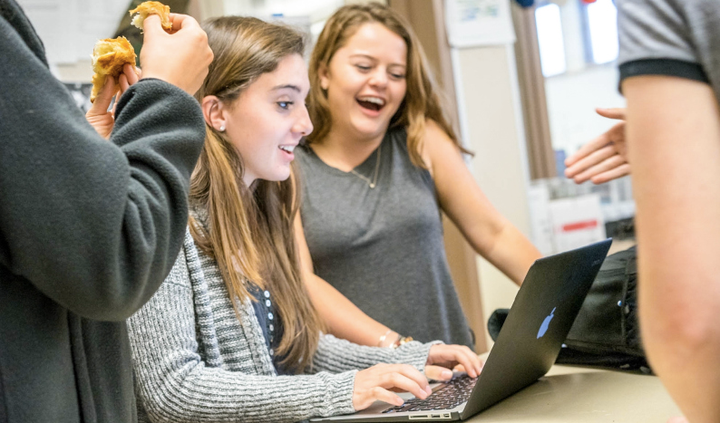
Typical student day in class in Palo Alto High Media Arts program. Students collaborate
– And on a final note: what is your opinion about e-learning? For instance, online universities, with Skype tutoring and open-access educational resources? They make education more accessible but also there’s less communication involved – both communication between students and between the student and the professor.
Let’s take a look at the most famous and successful e-learning programs such as Coursera, Udacity or edX. The dropout rate at all of those is disastrous: it’s 95%. I think that will tell you something about how effective e-learning is. And the reason it’s not effective is indeed because of the lack of interaction, collaboration and communication. Of course, they can apply some changes to that which might work. One thing that they could do is have more Skype calls, more videoconferences. Another possible solution would be to have students work in some environment together (it could be some virtual space). It’d be good if they had to do e-learning, say, for 50% of the time, and spend the other 50% talking about it to somebody. And the deal breaker is the same thing I said earlier: interaction. That’s why e-learning alone is still not very effective.
We need to understand that technology is kind of like a lubricant: it helps to facilitate education and make it easier, faster, smoother. But the essence of education is still in interaction. People can only learn from other people, they learn by interacting with each other, and by doing something. That makes the difference.
T
